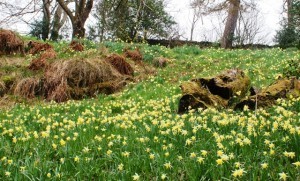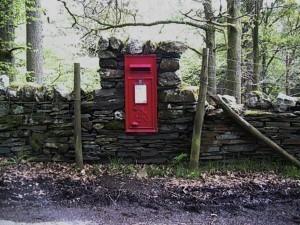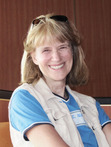Kit Bakke's Blog, page 7
June 24, 2014
Summer Afternoon–most beautiful words in English language

On the Turkish Aegean Coast in early June
As I was on vacation until a week or so ago (see picture! our boat! still pinching myself–it can’t be real!) June and July go together on our meander through the 1946 Farmer’s Almanac. It’s the summer effect—summer expands time into endlessness and compresses it into one beautiful afternoon. It’s best to go with the flow.
The June entry in the Almanac begins: “This is the month of young love and young leaves. Look for trouble on both. Get your sprays ready,” and ends with “Keep the weeds down now and from now on you’ll have clean sailing—maybe.”
I’m beginning to get to know this Almanac writer—it’s always glass half full/glass half empty with him. July if full of these switcheroos. He paints a beautiful scene, but can’t leave it alone without tossing in worries, proscriptions and reminders of disasters to be avoided. Here’s July:
“The old swimming hole and the beaches are grand places this month, but have a care. More mastoids, earaches and chronic sinuses are developed through diving (especially in fresh water) than in any other way. Water up the nose is more dangerous than water in the ears. …You’ve earned your vacation, so why ruin it by going after than tan in too much of a hurry? Keep your shirt on most of the time. As usual this month lots on non-essential brains will be addled in the noontime sun, but not the farmer’s. He doesn’t wear that kind of a hat because he’s a ‘hick’ but because he’s got work to do—in the sun. Why not give him a hand…?”
July ends with “Dried alfalfa, mullein, cornsilk and raspberry leaves are now in season and will insure you a hot time in the old pipe tonight. But you could do worse when it comes to rolling your own.”
And so it goes.
What’s your summer hold for you?
PS: title quote, by the way, from Henry James
The post Summer Afternoon–most beautiful words in English language appeared first on Kit Bakke, author of Dot to Dot and Miss Alcott's E-mail, books for thinking kids and choosy grown-ups..
May 4, 2014
The Merrie Month of May
Even the Farmer’s Almanac is feeling cheery in May. My 1946 edition (the year of my birth; although in May I’m still hanging out in my mother’s uterus) takes a break from telling farmers to get on with their chores. I notice in this entry an extraordinary number of commas. Seems as if we don’t sprinkle them about quite so much these days.
But the idea of foraging and eating fiddleheads and wild turnips is on the cutting edge of the trendiest restaurants and chefs around the world in our twenty-first century. Noma in Copenhagen has for several years been considered the best restaurant in the world, and much of what they serve is exactly this sort of thing.
Finally, I find it interesting that MS Word doesn’t recognize “kine” as a word. Hope you do. Enjoy this peek into a May of the past:
“About this time of year we hunger for something that’s fresh and green and sprout and that we can see growing. We would browse like the kine, if we were made for browsing, but the instinct to get something lush between our teeth is just the same as theirs.
This leads many people to eat weeds—such as dandelion, mustard, and wild turnip—or nibble at bittersweet or root through the woods for fiddleheads (the new curled shoots of a certain kind of fern which none of us recognize). Many find pleasure in chewing the twigs of black birch and sassafras.
The violet, as a salad delicacy, has its advocates (the same, we believe, who eat rose petals later). Then there are those of the chive and garlic school who like nothing better than a dish of skunk cabbage. But, no doubt, the digestive organ of these gourmets are greatly exaggerated.
This, of course, is but a small list of the edible inedibles to be found in our woods and fields this time of year, but still it is long enough to be dangerous. Few, if any of us, know what we’re looking for and so are likely to browse on the Lord knows what. It’s a lot safer to go back to the old diet of beans and spinach till the radishes come up. By then the madness will have left us.”
The post The Merrie Month of May appeared first on Kit Bakke, author of Dot to Dot and Miss Alcott's E-mail, books for thinking kids and choosy grown-ups..
April 9, 2014
Advice for April
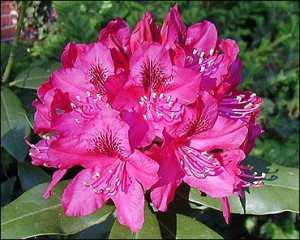
The rhodie is the Washington state flower
Continuing my meander through the 1946 (the year of my birth—although in April, I’m not yet in the world) Farmer’s Almanac, the April advice seems as if it could be written for 2014:
April is the month of showers (or snow flurries) sandwiched haphazardly between the gales of March and the langors (sic) of May. With one foot on the threshold of spring and one at the backdoor of winter, it hangs uncertain which way to fall—and it’s never what it’s cracked up to be.
However, it has just enough promise of something better in it, after something so very much worse, that it relaxes us willy nilly. We get what is known as “spring fever,” a misnomer if there ever was one. We aren’t feverish at all and the “spring” is all out of us for certain. We may yearn and intend and plan, but we do nothing—willingly, or, rather, we willingly do nothing. When the breath of life is on all the world, we lie torpid.
But then the almanac advisor pulls himself together and tells us that we can ease into the chores of spring by burning off our cover crops—“it’s idle and easy, and that’s what we’re after.” But after that, it’s all work, work, work resetting fence posts, mulching strawberry beds, setting out new fruit trees, ploughing, mending walls.
So even if you are just ploughing new thoughts and mending old quilts, try to find a shaft of spring sunlight to do it in…. Cheers to all! This is really where the new year begins…
The post Advice for April appeared first on Kit Bakke, author of Dot to Dot and Miss Alcott's E-mail, books for thinking kids and choosy grown-ups..
March 16, 2014
Baby Porcupines in Tomato Sauce
The month of March has crept up on me from behind and turned me into a slacker. Why? Because I have a goal this year to review the 1946 Farmer’s Almanac at the beginning of each month. Why 1946? Because that was the year I was born. The newsy bits and advice from the 1946 Farmer’s Almanac give me a peek into the sorts of issues that concerned and entertained Americans like my parents—besides, in their case, taking care of their darling first born.
The advice in the Farmer’s Almanac for March 1946 has to do with seeds and mud, and isn’t all that interesting. Instead, moving on toward the back of the Almanac’s 80 pages, we find some dietary advice: “Three Square Meals a Day” by Louise Pryor Skilton. Ms. Skilton (I probably should say Mrs. Skilton) first reveals that “the modern scientist…has added a new meaning to the old expression” three square meals. “To him (of course it’s a him) a meal is ‘square’ if it supplies foods for energy; protein foods for growth and repair; mineral; and vitamins. Today’s homemaker finds that she (of course it’s a she) can plan meals to meet this latest definition by using basic patterns…”
Mrs. Skilton goes on to list three basic meal patterns. Breakfast is: “fruit, cereal with milk, whole wheat toast or muffins, milk for children and coffee for adults.” Lunch and dinner both include dessert.
The homemaker of 1946 is then treated to several of Mrs. Skilton’s recipes. Here’s the first one, which turns out not to be what its name suggests. Has anyone ever heard of this dish?
Baby Porcupines in Tomato Sauce
1 pound hamburger
1 T minced onion
2 t baking power
½ cup milk
1/8 cup uncooked rice
1 10 ½ can condensed tomato soup
1 ¼ cups water
Combine hamburger, onion, baking powder, salt, milk and rice. Shape the mixture into small balls and put them in a skillet. Four over them the tomato soup mixed with the water. Cover the skillet and simmer over low heat 1 ½ hours. Serves 4-6. Serve with parsley potato, green beans, and grated carrot salad. Use lemon sherbet for dessert.
The post Baby Porcupines in Tomato Sauce appeared first on Kit Bakke, author of Dot to Dot and Miss Alcott's E-mail, books for thinking kids and choosy grown-ups..
March 13, 2014
ZIPS goes wandering
One of the unfortunate things about having your children grow up and leave home is not just that they grow up and leave home, but that you no longer have an excuse to hang out in the children’s section of bookstores or read children’s picture books on a daily basis.
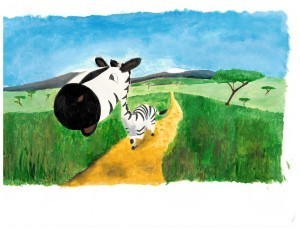 Lucky me to be writing about Chris Marsh’s new book ZIPS GOES WANDERING. Talented Chris has written and illustrated this story of an adventurous baby zebra, who like all explorers, runs into friends and foes and learns something about himself along with way. And, like all daring travelers in little children’s story books, Zips comes home safe and sound to his Mum.
Lucky me to be writing about Chris Marsh’s new book ZIPS GOES WANDERING. Talented Chris has written and illustrated this story of an adventurous baby zebra, who like all explorers, runs into friends and foes and learns something about himself along with way. And, like all daring travelers in little children’s story books, Zips comes home safe and sound to his Mum.
Yes, his “mum” because Chris is British and that’s what they call mothers there. So be prepared to read the rhyming story with an English accent.
I emailed Chris to ask him the crucial question about zebras: Are they black with white stripes or white with black stripes?
Here’s his answer:
There are many different ideas about this. Some say that zebras are white with black stripes because the black stripes tend to get thinner towards the belly. However some say that a zebra without its fur is black. That’s one of the reasons I find zebras such interesting animals. It really is a question that has baffled people for many years along with what are the stripes actually for. There are many different theories for the latter. The stripes can act as camouflage in forest environments but also when a zebra is in a herd it is difficult for a predator to pick out an individual from a wall of stripes. They also help to confuse flies who prefer to land on solid masses of colour and some say it helps a zebra maintain its temperature. What is known is that each zebra has a unique stripe pattern, like a human finger print. When a foal is born the mother will keep it close and block its view from other zebras so that the foal remembers her stripe pattern in case they ever get split up. If they do, the foal can pick out its mother from her stripe pattern - I think that’s pretty cute.
ZIPS GOES WANDERING is a lovely way for little kids to learn about the African savannah and to imagine their personal adventures in their own backyards and neighborhoods.
And here’s a Q&A blog about Chris: http://e-booksandkids.com/insights/entry/qa_with_author_illustrator_chris_marsh
The post ZIPS goes wandering appeared first on Kit Bakke, author of Dot to Dot and Miss Alcott's E-mail, books for thinking kids and choosy grown-ups..
February 22, 2014
Baking Bootcamp at the CIA
A few years ago, I took a week long baking class at the Culinary Institute of America’s fabulous facility http://www.ciachef.edu/california/ in the Napa Valley . The building, called Greystone, was once the largest stone winery in the world. Its imposing stoniness is set in 22 inch walls (for keeping the wine barrels cool and safe) in 1889. Over a hundred years later, it was bought and fitted out as the west coast version of the Hudson Valley’s CIA.
My husband’s parents live in the Bay Area, so we visit often. My mother-in-law is a terrific cook, and both of us like baking. So a few years ago, we decided to take the CIA’s baking boot camp. It’s a week’s worth of classes designed to help people decide if they want to take the full year’s course. It cost about $700, so not to be sneezed at.
The ten or so students were from all over the west. Some were like us, not looking to make a career of baking, and others were on their way to becoming the next pastry chef at the French Laundry or Eleven Madison. The class registrar told my mother-in-law that she was the oldest student they’d ever had. She was 79.
Class started at 7:30 am every day and went until after 4 pm. It really was a boot camp. If we messed up, the chef instructors told us to make it again. We shared the giant cooking space, equipped with the most wonderful ovens and cooktops, including bread-baking ovens with internal spritzers and the ability to adjust top and bottom heating elements separately, with a class of Hyatt Hotel chefs, coming in for a continuing education class. They prepared lunch every day for us. For some reason, we weren’t asked to provide the bread or dessert.
Our curriculum included everything from learning about yeast and the effect of various protein contents on flour, to practicing two kinds of cake mixing methods (the foaming method or the rubbed dough method), to making several breads and flatbreads (including naan in a real tandoori fire oven). On Friday we finally got to the chocolate part. Oh, and we made some pies too. It was the buttermilk pie that I had to do over.
Here’s my mother-in-law, telling the instructor how it was done in the old country.
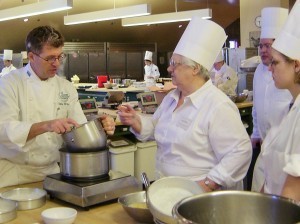
My mother-in-law telling the chef how it’s done in the old country.
The post Baking Bootcamp at the CIA appeared first on Kit Bakke, author of Dot to Dot and Miss Alcott's E-mail, books for thinking kids and choosy grown-ups..
February 10, 2014
February in a Nutshell
I am continuing my reading of the 1946 Farmer’s Almanac that my daughter gave me for Christmas. 1946 is when I was born, and it’s interesting to see what grown-ups were thinking about at that time. Of course, there was a lot about the ending of World War II—the dates that are noted in February 1946 have to do with the great battles on the Pacific Front—Guadalcanal in 1943, Eniwetok in 1944, Bataan in 1945, Corregidor in 1945.
One happy surprise was that, besides Lincoln and Washington’s birthdays, the Almanac singles out Susan B. Anthony’s birthday on Friday February 15. She was born in Massachusetts in 1820 and died in 1906, so only forty years earlier than the Almanac’s date. I expect many adults in 1946 were alive when Susan B. Anthony was alive (which gives me shivers; Susan was an amazing person. If you ever have a chance to visit her home and museum in Rochester NY, definitely do so. http://susanbanthonyhouse.org/index.php ). Even more people would have been alive in 1920, when Susan’s lifelong struggle for women’s suffrage was finally won in the U.S. She didn’t live to see it, but never doubted it would come.
“Failure is impossible” she said.
The 1946 Almanac advises farmers in February to be nice to their neighbors and help with clearing each other’s snowdrifts: “A touch of neighborly kindness goes a long ways—and there’ll be more storms coming.” The Almanac goes on to encourage people to keep their fireplaces, furnaces and stoves clean and safe because “more farms are burned out this month than any other—and chiefly through carelessness or lack of foresight.”
Snow cleared, and fires burning safely, the Almanac then suggests that families read aloud to each other: “have a thought of an evening…for the books you have not had time for. Let Mother and the boy and the girl share your pleasure with an occasional hour of reading aloud. Don’t be ashamed of the old favorites: Dickens, Jules Verne, Longfellow, Mark Twain, etc., but don’t overstrain their credulity with too large a dose of Cooper. Have the youngsters introduce books and magazines of their own.”
There you have it. February in a nutshell.
The post February in a Nutshell appeared first on Kit Bakke, author of Dot to Dot and Miss Alcott's E-mail, books for thinking kids and choosy grown-ups..
January 1, 2014
Happy New Year, version 1946
My eldest daughter bought me a copy of the Farmers Almanac for 1946, the year of my birth. Its 80 pages are crammed with astronomical, historical and nutritional data, as well as postal rates and summaries of the major events of the previous year. Each month has a page which includes advice and things to think about.
Here’s January’s:
No place like a farm for cobwebs and rust and decay, give them half a chance. And too many of us do. For cobwebs have a way to getting into he think machine of farmers, rust gathers on those fine new ideas and enterprise decays.
For instance, are you a milk farmer, only, with more stock that you can properly take care of, and half of these second rate? Why not less of better quality? May you just about make ends meet, but does it make dollars—or, sense—to sell your milk wholesale and buy your grain retail? Why not raise your own grain? Have you looked into the idea of cooperative marketing and buying? What about raising a cash crop or two with the time saved by less and better stock?
Do you let your machinery ‘weather’ out? Good sheds are one of the best investments. How many machines have your really worn out?
Are you content to let your soil wash or blow away year after year because you plow up and down slopes rather than around, fall plough without a cover crop, overpasture, or clean cut your wooded slopes?
Last—have you kept careful records of your farm business—records that can truly show you where to stop your dollars when tjey have run too fast? Sound farming methods and good records are the key to a HAPPY NEW YEAR.
December 19, 2013
Dorothy Wordsworth, Not to be Forgotten
“Neither Absence nor Distance nor Time can ever break the Chain”
(Dorothy Wordsworth, 1788)
In a chapter entitled “Open Heart, Open Mind” in my new novel Dot to Dot, I quote Dorothy Wordsworth saying “a good walk always calms my nerves” to Mary Wollstonecraft, as the two women stride across the green and heathered hillsides surrounding Derwentwater in northwest England’s remote and stormy Lake District.
Dorothy Wordsworth lived most of her life in the Lake District with her adored brother, the Romantic poet William Wordsworth. She loved a long walk and didn’t think twice about hiking twenty miles in heavy shoes and long skirts to visit friends, often returning after dinner with only moonlight to mark the narrow, rocky and often muddy path home.
Today the Lake District remains a hikers’ paradise, chockfull of blue lakes, purple hills, volcanic, slate and granite outcroppings, and almost two thousand miles of public footpaths. Oh, and those dancing daffodils, too. More on them later.
I’ve enjoyed many Lake District rambles over the years, and it was great fun to place some of Dot to Dot’s action in amongst the area’s staggeringly gorgeous views. Making the place even more attractive, the Lake District’s valleys and peaks are littered with a thousand years of human history, from ancient standing stones to Beatrix Potter’s farmhouse, to the tiny daisy-studded graveyard in the bend of the River Rothay where Dorothy Wordsworth was buried in 1855.
I like walks that mix history with scenery.
The more I learned about Dorothy Wordsworth, the more I knew I had to include her in Dot to Dot. Dorothy Wordsworth is an unsung literary hero, the proverbial woman behind the man, never complaining while doing everything from the housekeeping (which in those days included planting, tending and harvesting vegetables, chopping wood, making bread, hauling water and endless cleaning), to sitting on hard chairs in cold rooms while making fair copies of her brother William’s poetry by candlelight. (Their now famous Dove Cottage was then quite drafty, cramped, damp, dark and inconvenient.). She also courageously mediated the increasingly difficult relationship between William and Samuel Taylor Coleridge so that they could revolutionize English poetry. Which they did, with Lyrical Ballads in 1798.
Dorothy is just one of three English women I marshaled from the literary past to help Dot to Dot’s main character, a twelve year old girl named Dot, get her life back together after witnessing the bloody but accidental death of her mother. The other two are Mary Wollstonecraft and Jane Austen. Each represents a particular trait that Dot’s mother wanted her daughter to understand and value. Part of the fun of reading the book is figuring out just what Dot’s mother was trying to communicate to her daughter, and then watching Dot’s adolescent attempts to understand it all.
But back to those daffodils. Probably the best known Wordsworth poem is the one that begins “I wandered lonely as a cloud” and goes on to describe seeing “a host of golden daffodils; beside the lake, beneath the trees, fluttering and dancing in the breeze.” All very nice, but it turns out that many of Wordsworth’s poetic descriptions of nature exist because his sister Dorothy told him about them, or wrote descriptive phrases in her journal after they’d taken a walk together. He would then read her journal as a way of jumpstarting his poetry-writing. She wrote that she kept the journal only “to give Wm pleasure by it.”
William never gave Dorothy formal credit for her contributions to his topics or his phrasing, although when you know where to look, you can see his occasional references to her as “Friend,” and once he wrote that “she gave me eyes, she gave me ears” in his poem The Sparrow’s Nest, but still never naming her. Dorothy herself said she never had any interest in writing poetry, but she did write the occasional poem and essay, and typical of the day, lots of letters.
Mary Wollstonecraft, Jane Austen and Dorothy Wordsworth’s lives overlapped in the tumultuous and, for the British, worrisome late 1700s, when the American colonies threw off ties to their monarchy, and the French were doing the same, even more violently. All three of these English women responded differently to this social instability, Mary Wollstonecraft being the most dramatic, as she went to Paris to witness the revolution first hand. She is best known for her ground-breaking A Vindication of the Rights of Woman. Jane Austen needs no introductions these days, but her appearances in Dot to Dot reflect my own reading, multiple visits to her home in Hampshire and long-time membership in the Jane Austen Society of North America.
As Dot travels in England with her eccentric Aunt Tab, she runs into more history than she knew existed. As Aunt Tab tells her, “travel isn’t only going from place to place.” And history, it becomes clear, is a lot messier than Dot had realized. Making her way through the messiness of the past begins to help Dot find her way in the messiness of a future without her mother.
Fairly early on, Dot becomes particularly interested in Mary Wollstonecraft’s daughter, also named Mary, in part because she was also motherless (Mary Wollstonecraft died of labor complications when daughter Mary was born), but also because as a teenager, daughter Mary wrote the original story of Frankenstein while running away from home with her half-sister, her boyfriend (the wealthy but revolutionary poet Percy Shelley), and Lord Byron and who was known at the time as “mad, bad, and dangerous to know.” Both Shelley and Byron were married to other women at the time—they were all running away from stuffy London society. As Dot reads Frankenstein she takes note of the fact that, like her own life is more nuanced and unexpected and just plain interesting than she’d realized.
Write and tell me your favorite places. I’ll be waiting at the mailbox.
December 10, 2013
Read On!
“Having books around to just pick up when I want makes me feel like a normal person.” Resident at a transitional housing shelter for women in Seattle.
Four years ago, in the tag-team way people make friends, a group of Seattle authors found themselves getting together once a month to complain about the book-writing-and-publishing business. Each of us had a traditionally published book or two or three, so we were all scarred by the various battles, snubs, delays and disappointments that accrue to an author, especially one on the west coast dealing with the major New York publishing houses.
Being published is not all beer and skittles, not by a long shot. However, we knew only too well that writers who haven’t been published have absolutely zero sympathy for these problems. And of course our friends in regular day jobs also have no tolerance for hearing complaints from people who could work at home in their PJs every day. We could only whine among ourselves. So we did, at a local bar on Capitol Hill, calling it our “wine and whine” time.
After a year or so of this, we started to even bore ourselves, so we decided to DO something. What? Well, something that would support and encourage writers, readers and booksellers in the Pacific Northwest. After all, that was the ocean we swam in—let’s make sure it remains healthy and productive.
So we named ourselves Seattle7Writers, became a nonprofit organization, put up a website and went to work. We give writing workshops, raise money for grants to local literacy organizations, and collect and donate books to homeless shelters, detention centers, recovery and transitional facilities, and food banks—anywhere people have less than perfect access to large libraries or bookstores.
To date we have distributed over fifteen thousand books to about twenty regional facilities. We collect books from our publishers, local bookstores, local book reviewers and from people who just hear about our work and want to contribute.
We pay attention to our recipients’ requests—shelters that provide only night-time use want only paperbacks because their clients spend their days on the streets and don’t want to haul around heavy hardbacks. Women’s shelter residents don’t want to read about graphic violence against women, because they’ve lived it and don’t find it an entertaining topic. None of our readers need books about ways to resolve rich people’s angst or how to plan a month’s vacation sailing in the Mediterranean.
What they do want is what we all want from books: to pass the time with a new friend, to learn about a new place, to meet a new idea. And to do it all safely in a world that hasn’t been particularly safe or comfortable in the past.
So here’s to giving away books on this holiday season! And here’s a toast to the most important people in the whole writing business: READERS!
See more about Seattle7Writers at www.seattle7writers.org

